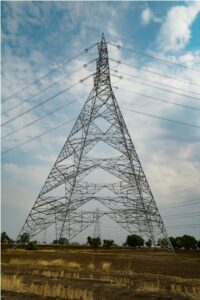G R Infraprojects Ltd (GRIL) recently commissioned its first power transmission project, won under competitive bidding. Housed under “Rajgarh Transmission Ltd,” this interstate transmission system (ISTS) project aims at RE evacuation from the Rajgarh solar energy zone in Madhya Pradesh. In this exclusive exchange, we have Ashwin Agarwal, Business Unit Head – Power Transmission, G R Infraprojects Ltd, discussing the project execution challenges and how they were successfully surmounted. He also dwells upon Pachora Power Transmission, the second ISTS project that GRIL very recently won. Ashwin Agarwal notes that companies like GRIL, with rich experience in the infrastructure EPC sector, can play a vital role in India’s power transmission development space. An interview by Venugopal Pillai.

We understand that Rajgarh Transmission Ltd has newly commissioned its ISTS project in Madhya Pradesh. Is the project fully commissioned and operational, which is to say has the SCOD been officially notified?
I am proud to mention that Rajgarh Transmission Ltd (RTL) has successfully commissioned its ISTS project in Madhya Pradesh. The project is now fully operational and has achieved its COD on April 2, 2024.
We broadly learn that the Rajgarh project will help evacuate 1.5 GW of renewable energy from the Rajgarh solar energy zone (SEZ) in Madhya Pradesh. Tell us more. What are the major elements covered in this project?
RTL will facilitate the evacuation of 1.5 GW of renewable energy from Rewa Ultra Mega Solar Ltd (RUMSL), Madhya Pradesh. Major elements of the project involve 400/220kV AIS substation along with 150 km of double-circuit twin HTLS transmission line.
Our robust infrastructure will help enhance power reliability, reducing outages and ensuring a stable electricity supply for homes and businesses, thereby contributing to a cleaner environment and better public health. We are proud that this project will bring such significant benefits to the public, fostering sustainable and economic development.
 The project, as we learn, was slightly delayed from the original commissioning date of November 2023. What were the reasons for this delay and how were the issues resolved?
The project, as we learn, was slightly delayed from the original commissioning date of November 2023. What were the reasons for this delay and how were the issues resolved?
Yes, RTL experienced a slight delay from the scheduled commissioning date of November 2023. Such large-scale projects often face execution and integration challenges at various levels. In this case, the delay was primarily caused by a combination of factors, including statutory and regulatory approvals, force majeure conditions, and other right-of-way (RoW) challenges. These issues were resolved through diligent coordination with relevant authorities, meticulous planning, and adaptive strategies to mitigate unforeseen circumstances. Despite these hurdles, we are pleased to have completed the project and our proud that it has begun to deliver its promised benefits.
Rajgarh Transmission was your first power transmission development project. What has been the major learning from the successful commissioning of this project? How do you plan to leverage this experience for your second project – Pachora Power Transmission Ltd (PPTL)?
As our maiden endeavour in power transmission development, the successful commissioning of the RTL has marked a significant milestone for GRIL in the energy sector. Throughout this journey, we have accumulated invaluable insights into new technologies, project management, and financial stewardship. Leveraging these experiences and lessons learned, we aim to execute the Pachora Transmission project with even greater efficiency, bolstered by enhanced risk management, optimized resource allocation, and superior project outcomes.
Incidentally, has work begun on the Pachora project? We also understand that the Pachora project is related to the Rajgarh project as both are associated with the Rajgarh SEZ. What advantages does this provide?
 Yes, work has commenced on the Pachora project, which is closely related to the Rajgarh Project as both the assets will contribute towards power evacuation from the same renewable energy source, RUMSL. Leveraging the existing infrastructure and skilled resources from the Rajgarh project, GRIL is poised to ensure the successful completion of PPTL.
Yes, work has commenced on the Pachora project, which is closely related to the Rajgarh Project as both the assets will contribute towards power evacuation from the same renewable energy source, RUMSL. Leveraging the existing infrastructure and skilled resources from the Rajgarh project, GRIL is poised to ensure the successful completion of PPTL.
Currently, land development works in the substation area and detailed route survey for the transmission line are underway for the PPTL. This proximity between the two projects within the Rajgarh SEZ offers several advantages, including streamlined logistics, shared resources, and synergies in project management, ultimately facilitating a more efficient and cost-effective execution process.
With significant opportunities currently available in India’s power transmission development space, both intrastate and interstate, how do you see the years ahead for GRIL in this domain?
GRIL is well-positioned to take advantage of the burgeoning opportunities in India’s power transmission development sector. By leveraging government support, technological advancements, and strategic partnerships, GRIL aims to make substantial contribution towards the nation’s power infrastructure development while ensuring sustainable and profitable growth. The years ahead look promising for GRIL as it continues to play a pivotal role in shaping India’s energy landscape through its unwavering commitment to excellence.
All project photographs in this interview relate to the Rajgarh power transmission project of G R Infraprojects Ltd.


